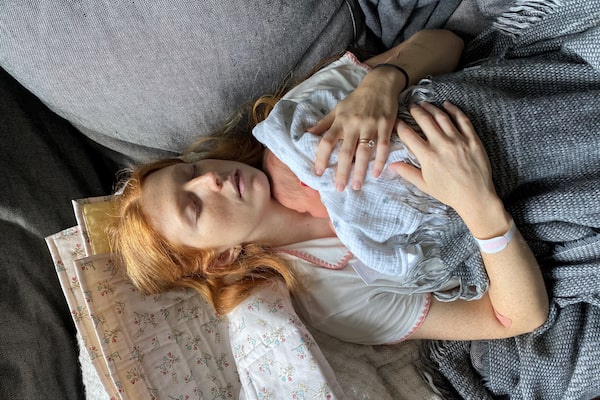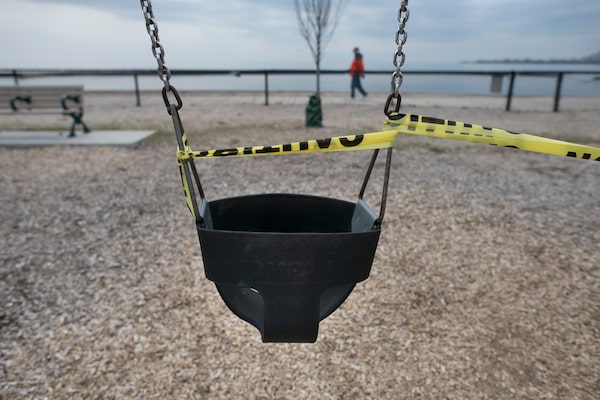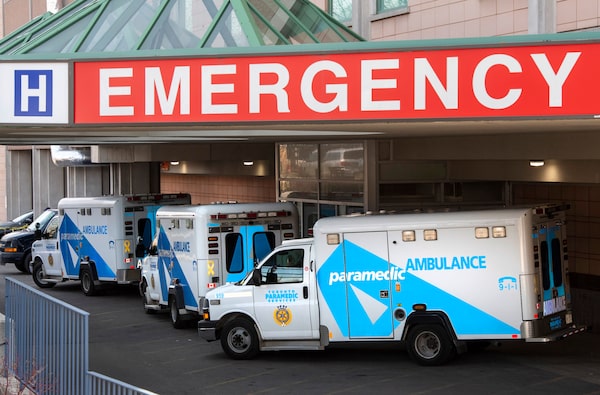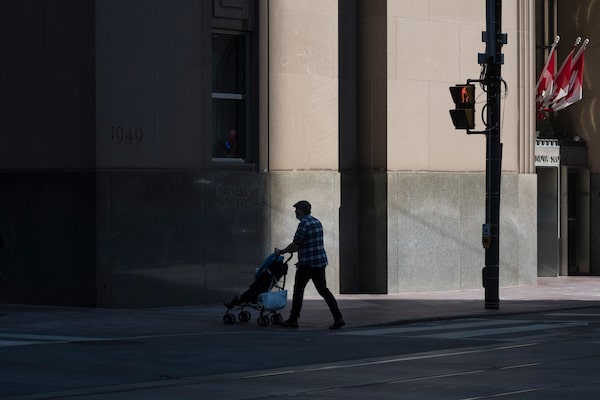
Emma Knight holds her daughter a day after a visit to a Toronto hospital where she went to be examined for a fever and pain after the delivery.Courtesy of Emma Knight
Emma Knight’s latest book is How to Eat with One Hand. She is a co-founder of Greenhouse, an organic beverage company.
On the Sunday afternoon before Labour Day, in the lull between the pandemic’s first two crests, I said goodbye to my husband and three-day-old daughter in the driveway of a Toronto hospital and made my way through the door marked EMERGENCY.
The nurse at reception slid me a number under a Plexiglas barrier. I lowered myself into a seat in the waiting room. The woman with her head in her lap was called first. Next the preschooler with his face nestled in his mother’s shoulder. Then the groaning young man with his foot in a cast, his wheelchair pushed by a woman with blue fingernails. The “No Companions” rule, communicated via temporary signage, mercifully did not apply to children or those unable to walk.
When my number was called, I forced my voice through the wall of clear plastic: “I had a baby three days ago, and now I have a 40-degree fever. My midwife told me to go to Emergency.”
A nurse in a disposable yellow gown took my temperature, twice. “It’s high,” he confirmed, sounding (to my ear) a touch impressed.
I listed my other symptoms: heavy bleeding, headache, chills, abdominal cramping. “On a scale of one to 10, how much pain are you in?” he asked.
“Six,” I lied. The pain was closer to 11, but I hated to seem like a lightweight.
Under my blue surgical mask, salty tears were dripping into my mouth. There was a box of tissues on my side of the barrier. I tucked extras into my sleeve. It would be 12 hours before I was wheeled out of the ER on a stretcher, still burning with fever.
Childbirth is unpredictable, and it can be dangerous. Preventable causes relating to pregnancy and childbirth killed one woman every two minutes globally in 2017. Canada is far from being the most dangerous place in the world to give birth, but it’s not the safest place, either. There were 38 countries ahead of Canada in the World Bank’s last global ranking of maternal mortality rates.
In the years leading up to the pandemic, as many countries made strides in reducing their maternal mortality rates (MMRs), Canada’s rose. The government’s most recently reported MMR, defined as deaths from obstetric causes occurring during pregnancy or within 42 days of delivery or end of pregnancy, was 8.3 deaths per 100,000 live births in 2018, up from 5.9 in 2017.
Doctors like Jon Barrett, chair of the Department of Obstetrics and Gynecology at McMaster University and a member of the Society of Gynecologists and Obstetricians of Canada (SOGC), have long been sounding the alarm that these numbers do not tell the whole story.
In 2010, the World Health Organization urged the SOGC to work with national and international experts to review how maternal mortality is monitored in Canada. What they found was troubling: There was little standardization in definitions, data collection methods or review processes across the country, and no national system for reporting on or learning from deaths and near misses. Thus, the SOGC warned in 2019, we have “no accurate national picture” of how many women in Canada are dying of causes related to pregnancy and childbirth each year – or why.
COVID-19 has not made childbirth safer. Global rates of stillbirths and maternal deaths have risen by around a third during the pandemic, with pregnancy outcomes getting worse overall for both babies and mothers, especially in low- and middle-income countries, according to an international data review published in the medical journal The Lancet Global Health in March.
Beyond the danger posed by the virus itself, factors such as the avoidance of medical settings, overburdened hospitals and health care workers and the virtualization of care are worsening existing inequities in maternal health care and making it more difficult to prevent “adverse events” – an anesthetized way of describing the loss or near loss of a mother’s life.
Now is the time to put an end to preventable maternal deaths in Canada. The first step is to understand the problem. We need a co-ordinated system for tracking maternal mortality across the country and a confidential enquiry system to investigate every maternal death and near miss, as the doctors of the SOGC have been prescribing for more than a decade now.
We expect childbirth to hurt; in 2021, it should not kill.

Caution tape surrounds a swing at Sir Casirimir Gzowski Park on the Toronto waterfront in March of 2020, soon after the first COVID-19 restrictions closed off the city's play structures.Fred Lum/The Globe and Mail
My husband Anthony and I found out I was pregnant with our second child at around the same time the world realized that COVID-19 was going to be a problem. “The mayor closed the park,” our two-year-old informed us one afternoon last March.
Ontario had declared a state of emergency. Hospitals had stopped accepting visitors and started calling for donations of personal protective equipment. Our daughter was right: The playground looked like a scene from a Swedish crime novel, slides choked with yellow caution tape, vacant swings creaking ominously. She rode her scooter in circles against a grey sky.
I was afraid of many things at that time, but not of giving birth during a pandemic. In fact, I thought I was uniquely prepared for the task. Two years prior I had given birth at home, somewhat by accident. Labour had come on like a summer storm. Pummelled by contractions, unable to imagine climbing down the stairs and into the car, I had climbed into the bath instead. This may not have been the smartest decision from a pain-management perspective, but it worked. So, when my midwife asked where I wanted to deliver the second time around, I proudly pointed to the home birth on my CV.
Our second daughter landed swiftly in the bath right before the Labour Day long weekend. Her birth took four hours all-in, and while the speed meant there was less time for hormones to take the edge off (the edge felt like a chainsaw), I received excellent support from two midwives. The home birth was covered by Ontario’s Health Insurance Plan and cost taxpayers significantly less than a doctor-assisted hospital birth. Our midwives continued to take care of us for several hours, bringing me warm broth and helping me nurse my daughter. In the early morning light, as I fell asleep in my own bed, I thought, briefly, that we had pulled off something close to the ideal birth.
Two days later, the contractions that seized my abdomen during breastfeeding were as painful as labour had been. My scalp was on fire. Liquid nitrogen was being injected into my bones. I spent a day and night in and out of cold sweats before deciding it might be more than just the hormonal fireworks of my milk coming in.
Anthony unearthed the thermometer. We texted our midwife, who called us immediately. “Go to Emergency,” she said. I was reluctant. Four years ago, I watched a close friend die very suddenly after he contracted an infection in a hospital from an antibiotic-resistant bacterium called MRSA. Consciously or not, I had avoided hospitals ever since. We called Ontario’s health hotline and a doctor friend. “Go to Emergency, now,” they said. My mom came to look after our toddler. We packed up the baby (she still felt like a part of me) and got in the car.

A paramedic closes the doors on an ambulance at a Toronto hospital this past April. Ontario's ERs have been much busier with COVID-19 cases recently than at the end of last summer when Ms. Knight's baby was born.Frank Gunn/The Canadian Press
That Sunday afternoon, once the triage nurses had admitted me to the Emergency Department, I found myself in what looked like a vast, blindingly lit parking lot for stretchers. My curtained-off stall felt sun-adjacent and contained, along with my stretcher and IV stand, a beeping machine that seemed hostile to my presence.
“Nurse!” a man bellowed from across the aisle in a gravelly baritone. “Nurse! I need oxygen!”
“Oh shut UP,” came a choked voice from my left. “If you needed oxygen so badly –” the voice’s owner drew a difficult breath – ”you wouldn’t be wasting it.”
“We all need oxygen,” came another shallow voice.
“NURSE!” the man continued, dragging up his most withering authority. “OXYGEN!”
“You’re on oxygen,” the nurse told him patiently, arriving on the scene.
“TURN IT UP. And then I’m going for a walk to get a coffee,” he said wishfully.
A doctor around my dad’s age appeared over my stretcher to ask me whether I had any STDs. In return, I asked him what the blood tests he had just ordered were for.
“Sepsis,” he said.
I Googled sepsis. Not a good idea unless you know you don’t have it.
Some of the people arriving at my stall knew more about what ailed me than I did, and others knew nothing at all. A young man from the latter camp stuck a COVID swab up my nose. “Are you afraid it will hurt?” he asked me beforehand. I told him I had recently given birth. “Oh, you’ll be fine,” he said. “Where’s the baby?” he added, looking around as if he might have missed her.
Another man came by, puzzlingly, to give me a chest x-ray. “Is there any chance you might be pregnant?” he asked.
After the gynecologist examined me and I had been left alone to shiver, sweat, pump milk and fear death for a few more hours, a porter appeared to wheel me into a freight elevatorlike chamber. The ultrasound technician laughed at me as she prodded my sore abdomen. “What did you have a home birth for?” she mocked. Rolling the cold probe across my belly, she must have seen the eight cm-long clots of infected tissue floating across her screen. Perhaps she knew they were retained products of conception, or leftover pieces of placenta, which can get infected as the uterus tries to expel them. If so, she did not let on.
Retained products, I later learned, are nobody’s fault and can happen whether a woman gives birth at home or in a hospital; sometimes the placenta just doesn’t make a complete exit. Midwives and doctors are trained to examine the organ after birth to see if it looks like any pieces are missing – I know my midwives did – but it’s not always obvious. If they are small enough, the retained products sometimes pass on their own. If they are larger, they require removal, usually through a procedure known as a “D and C” (dilation and curettage). If left untreated, retained products can lead to the most common causes of maternal death: hemorrhage and infection or sepsis. Sepsis is a condition caused by the body’s response to an infection; it can turn into septic shock, which can kill you in a matter of hours.
n ER nurse arrives to treat a patient at Toronto General Hospital's emergency room last fall.Cole Burston/The Globe and Mail
Twelve hours after my arrival in the emergency waiting room, soaked through with sweat and still by turns broiling and freezing with fever, I witnessed the ER nurses save the life of a man who was overdosing in the stall across from mine. Soon after they got the life-saving needle into his vein, three porters wheeled my stretcher through dark corridors to an isolation room in the birth and recovery unit. It was large, dark except for a clock that glowed red on the wall, and blessedly silent. Every few hours a kind nurse came to check my vitals. By early morning, the fever had broken. I wasn’t allowed to eat or drink, but remembering birth scenes in movies, I requested ice chips. They melted deliciously under my tongue.
That afternoon, a gentle obstetrician wheeled me upstairs for surgery. Something new was put in my IV, and I slid into welcome oblivion. I woke up in a wide-open room with a nurse beside me. “Would you like a popsicle?” she asked. It was blue, and I devoured it. She offered me another.
Later, a doctor came to check on me. “Are retained products common?” I asked. She told me that three other women with the same complication had been admitted for D and Cs on the weekend. None had given birth at home. “Did they bring their babies?” I asked, wondering what happens if your family can’t spring into action at a moment’s notice.
“No,” she said.
“What if you don’t go to the hospital?” I asked.
“It gets much worse. Eventually you will go in,” she said.
“But what if you can’t get to one?” I persisted.
“You die,” she said.

A pedestrian pushes a child in a stroller through downtown Toronto this past April.Tijana Martin/The Canadian Press
Before, when picturing Canada’s health care system, I saw a single impenetrable castle, mostly filled with paperwork. Now I see many structures in varying states of repair spread out across our country. Because, of course, there is no single system; there are at least 13.
“Each province or territory determines how care gets delivered, and even within a province, care is uneven,” said SOGC member Dr. Barrett, reached by phone at Sunnybrook in Toronto, where he was leading the Maternal-Fetal Medicine unit through the second wave. “The ability to give maternal health care will vary from hospital to hospital, within regions, and certainly within populations, and so many people will fall through the gaps depending on which population they’re from, where they live and how they can access care,” he said, citing the insufficient maternal care in Indigenous fly-in communities as “a huge gap.”
Postpartum care is particularly unequal. Even though 42 per cent of women reported having “a great deal of a problem” with at least one postpartum health issue in the first three months postpartum in a 2009 survey by the federal government, women in Canada are not guaranteed much in the way of support after giving birth.
“The system falls apart in the postpartum period,” said Cecilia Benoit, a professor of sociology at the University of Victoria who studies the structure of maternity health care in Canada and internationally. Dr. Benoit described a “divided system” in which some women, such as the minority whose births are attended by midwives (as mine were) or family doctors, get continuous care throughout the postpartum period, but most do not. In Ontario, a single checkup (or phone call, during the pandemic) a full six weeks after giving birth is typical.
Hospitals discharge women within 24 to 48 hours (sometimes half that during the pandemic), down from five days in the mid-80s. Many birth units have a “no returns” policy, meaning that a woman with a postpartum complication can’t go back in with her baby; she has to make her way to the ER. How quickly she will be seen depends on how soon she realizes there is a problem, whether anyone listens to her and takes her symptoms seriously, where she lives, and whether she has access to transportation and emergency child care.
I, a white, urban anglophone with a well-equipped hospital and family nearby, received life-saving care from a team hamstrung by the pandemic. As I recovered, and for months afterward, I tried to understand what happens to the women in our country who don’t share these privileges. Here is what I have discovered: Some will not even become a statistic. It is worse than that. The tragedy of every death and the terror of every near miss is not yet being recorded and investigated in such a way as to save future lives.
The system we need is within reach. A model exists in the United Kingdom’s Confidential Enquiry into Maternal Deaths, a legislated surveillance program that captures information from midwives, doctors, coroners and members of the public for every maternal death, pinpointing quality breakdowns and publishing findings along with specific recommendations to improve care. The resulting reports reveal stark inequities. For example, the 2016-18 enquiries show that maternal mortality rates were four times higher for Black women and two times higher for women from Asian backgrounds compared with white women. They also show which maternal deaths might have been prevented and how. They are critical tools for bringing about life-saving change. Building a similar system in Canada might make our maternal mortality numbers go up in the short term – the 2012 British enquiry identified twice as many maternal deaths as data from vital statistics alone – but it is the first step in stopping preventable deaths.
Labour Day was not quite over. A few hours after the surgery, I was pronounced free of sepsis and COVID and discharged. At home, I clutched my daughters to my chest and watched Peppa Pig in a daze. Then the fever returned. Just after midnight, Anthony and I drove in silence back to the hospital. After three more days and nights of intravenous antibiotics, I was in the clear. It was time to start forgetting. When the worst doesn’t happen, and especially when the thing that keeps it from happening is privilege, the polite thing to do is to file your “scare,” along with your relief and your guilt, in a small box in your memory. Instead, I’m telling this story in honour of those who don’t get the chance to share their own.
Keep your Opinions sharp and informed. Get the Opinion newsletter. Sign up today.